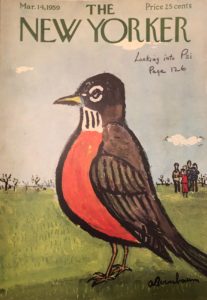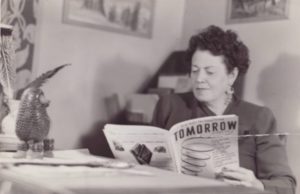
While trying to enjoy the dog days of summer I have been upside down in my “mystery boxes” of all sorts of Garrett correspondence, writings, interviews. So often people to this date continue to ask me what Eileen J. Garrett was really like. I happened to unearth the March 14, 1959 issue of The New Yorker Magazine which goes a long way to paint an accurate picture of my grandmother and PF’s first President. A great article “A Reporter at Large Looking into Psi” not only references PF and Garrett but provides a cogent history as well as overview of current research and commentary by such notables—the movers and shakers of that era: JB Rhine, Laura A. Dale of the ASPR, Dr. Gertrude Schmeidler, Dr. Emilio Servadio, Dr. Jan Ehrenwald, Dr. Gardner Murphy. The author, Kevin Wallace, is to be complimented on a very balanced, informative and entertaining peek into the world of psi providing us with a rare snapshot of those stimulating and highly creative and productive times that we as researchers have been able to draw on and build upon in our current researches. Should anyone be interested in a scan of the entire article, please let me know.
So at this point let me share the author’s take on PF and our Mrs. G:
“Even psi must have its fiscal side. Since the American Society for Psychical research is not financing laboratory work these days, part of the money for Dr. Woodruff’s and Dr. Schmeidler researches, I learned, was put up by the Parapsychology Foundation, a non-profit corporation with headquarters at 29 West Fifty-seventh Street—a fourteen-story office building, formerly the home of Aeolian Hall, which the Foundation now owns. A couple of days after my visit to City College, I stopped in at the Foundation’s offices—a fastidiously decorated pale-gray suite taking up the entire floor—for a talk with Martin Ebon, the Foundation’s administrative secretary. An urbane former publicist and journalist of German birth, Ebon briskly informed me that since the Parapsychology Foundation went into operation, in 1951, it has been a major provider not only for psi projects conducted within the jurisdiction of the American Society for Psychical Research but for similar undertakings in the territories of such communicating bodies as Italy’s Centro Studi Parapsicologici, Denmark’s Selskabet for Psykisk Forskning, The Netherlands’ Parapsychologisch Institute der Rijksuniversiteit te Utrecht, Societies for Psychical Research in England, Indian and South Africa, and so on, covering practically all the earth’s principal land masses. Besides making grants of up to three thousand dollars a year to individual researchers, the Foundation materially assists psychical-minded institutions, finances regional and world conferences on special phases of psi, publishes a breezy bi-monthly newsletter here on research reports all over, and operates a European Research Center, in Saint-Paul-de-Vence, Alpes-Maritimes, France. In short, the Foundation gives what it can—an amount of money Ebon declined to estimate.
 The President of the Foundation, I learned, is the world’s ranking retired trance medium, Eileen J. Garrett, and the vice-president and all time champion cash contributor is the Honorable Frances P. Bolton, Representative from Ohio, whose reputation as “the richest woman in congress” is based on an inheritance from her uncle, Oliver Payne, an associate of John D. Rockefeller’s in Standard Oil. Mrs. Bolton, whose far-flung enthusiasms over the years have included elevating the professional status of nurses, improving the flow of information from Africa, and fostering the spread of Basic English, got financially interested in psi in the nineteen-thirties, around the time she met and hit it off with Mrs. Garrett, who is herself one of the more fascinating psychical phenomena of our times.
The President of the Foundation, I learned, is the world’s ranking retired trance medium, Eileen J. Garrett, and the vice-president and all time champion cash contributor is the Honorable Frances P. Bolton, Representative from Ohio, whose reputation as “the richest woman in congress” is based on an inheritance from her uncle, Oliver Payne, an associate of John D. Rockefeller’s in Standard Oil. Mrs. Bolton, whose far-flung enthusiasms over the years have included elevating the professional status of nurses, improving the flow of information from Africa, and fostering the spread of Basic English, got financially interested in psi in the nineteen-thirties, around the time she met and hit it off with Mrs. Garrett, who is herself one of the more fascinating psychical phenomena of our times.
Mrs. Garrett, according to Ebon, has been endowed since her childhood—she grew up an orphan, in County Meath, Ireland—with what the gypsies of the locality recognized as second sight: a tendency to see shimmering objects in rainbow hues, which told her much about the inner nature of the people and objects involved; a tendency to be visited by apparitions of dying relatives; and a tendency to psychometrize inanimate objects, or promptly and involuntarily intuit their past history by touching them. In the years that followed, however, Mrs. Garrett was preoccupied with a series of not entirely happy marriages, business ventures, and illnesses, and she didn’t pay a great deal of attention to her disconcerting gifts until early in the twenties, when an acquaintance steered her to the British College of Psychic Science, a successor of the London Spiritualist Alliance. At this mediumistic proving ground, Mrs. Garrett learned the knack of falling into trances, and thereby became host, or hostess, to a garrulous “control,” who gave his name as Uvani. Declaring herself to be as dubious as the next person about the credentials of this Oriental wraith, Mrs. Garrett visited this country in 1931, at the invitation of the American Society for Psychical Research, and put herself and her “controls” at the disposal of psychiatrists at Johns Hopkins, as well as of various other investigators. (One of the latter, Hereward Carrington, satisfied himself, by means of a lie-detector and word-association testing of the visible Mrs. Garrett and the invisible Uvani, that there were two separate individuals. Another researcher—a one-“R” Carington with the given name of Whately—made substantially the same tests and concluded that a single, if split, personality was involved.) Whether her ghostly visitor was genuine or not, Mrs. Garrett found him to be emotional and egotistical beyond endurance, and she deplored the spineless dependency he seemed to endure in bereaved persons who consulted her. At last wearying of the whole thing, she threw it all up and went into the publishing business instead, setting up here in 1941, and bringing out a digest-size quarterly, called Tomorrow, which specializes in the writings of people interested in psi including herself.
Garrett Publications shares office space with the Foundation, and likewise shares Mrs. Garrett, since in addition to being the Foundation’s president she is Tomorrow’s editor. Ebon gave me a few issues to look through, and I was not surprised when he told me that Tomorrow enjoys a circulation of nearly ten thousand, or more than ten times the circulation of the Journal of the American Society for Psychical Research. Unlike the Journal, which pays its contributors nothing, Tomorrow pays a cent a word, and is consequently in a position to publish not only inspirational essays and respectable anthropological notes on primitive occultism but such circulation builders as “I Saw the Future in My Dreams,” by Romola Nijinsky; “Four Murders Solved by ‘Thought Reading;’” “Tahiti’s Death Curse;” “I Dreamt my Husband’s Death;” and “can Telepathy Penetrate the Iron Curtain?”

I told Martin Ebon (PF’s Administrative Secretary) that I would like to meet Mrs. Garrett, and in a matter of minutes I was face to face with her. A powerfully constructed, smartly coiffed woman in her sixties, turned out in a vivid blue dress of a stylish cut and a feathery trifle of a hat, she looked me over with commanding detachment as I lowered myself onto some white leather upholstery in front of her tooled walnut desk. Then she brightened (she explained later to a staff member, in my hearing, “I checked his aura. He’s not too destructive”)—or, rather, she didn’t so much alter her mood as replace her identity, becoming an intelligently degagee woman of the world going on forty, who told me, with rueful gaiety, “I’ve been guineapigging through one psychoanalysis after another for so long that I sometimes feel that psychical research has become just too dull and respectable for my tastes.” But it was not long before this disenchanted lady faded out and an informed scientific spokesman faded in, saying confidently, “We have important things to do here at the Foundation. We are busy locating and testing what will probably add up to hundreds of mediums all over the world, to cooperate in what may be the once-for-all experiment to establish or refute the reality of spirit communication, and so of life after death. Abruptly, a beatific smile smoothed Mrs. Garrett’s face, her eyes lighted up, and it was a roguishly poetic colleen of sixteen summers who went right on, in the most natural way in the world, “But, really, we ask—what survives, when every breath we take survives? Death is only change, perpetual death, from the moment we are born. This pattern we call ‘psychic’ is simply the language of the soul, our archaic language, and it comes to the surface in moments of stress, when for a moment we forget our everyday of facts and realize we aren’t spirits of some future time but creatures of divinity here and now….”
Creatures of divinity or not, I was in the condition of a groggy python being restored to its box when Mrs. Garrett let me go.”
Groggy Python remains an apt description of those in Garrett’s orbit as far as I can confirm by recollections of those who “survived Eileen Garrett” in response to my questions.
Leaving our past behind us, it is to the future we look with excitement! Dr Jack Hunter will now join us as a PF Research Fellow. Stay tuned for more details next month!